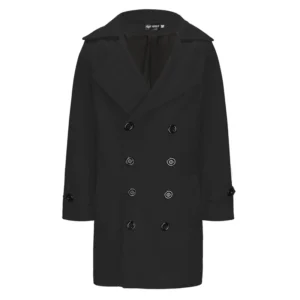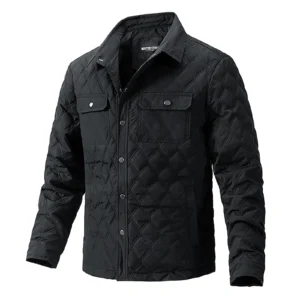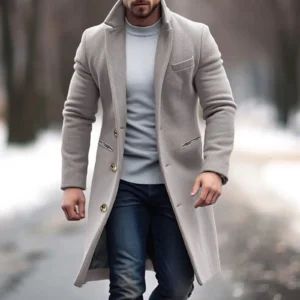Introduction: Understanding the Cost of a Classic Pea Coat
Pea coats stand as one of the most recognizable and enduring styles in men’s outerwear. With their distinctive double-breasted design, broad lapels, and structured silhouette, these naval-inspired coats often come with price tags ranging from $200 to well over $700 – considerably more than many other winter coat options.
Originally designed for sailors braving harsh ocean conditions, pea coats have transitioned from military necessity to civilian fashion staple while maintaining their core functionality. This maritime heritage represents just one factor in their premium positioning in the market.
What exactly makes these classic coats command such prices? The answer lies in a combination of premium materials, expert craftsmanship, exceptional durability, and timeless design elements. When considering a pea coat, you’re not simply purchasing seasonal outerwear but investing in a garment designed to provide warmth, style, and functionality for many years to come.
Understanding the essential information about coat length considerations becomes particularly important when investing in expensive outerwear like a quality pea coat. Before making your decision, you might want to explore our collection of premium pea coats to see these quality elements firsthand.
Premium Materials: The Foundation of Quality and Cost
The materials used in a pea coat play the most significant role in determining both its price and performance. Quality pea coats use premium fabrics that directly impact warmth, comfort, and longevity.
Wool Quality: The Primary Cost Driver
The type, weight, and purity of wool used in a pea coat dramatically affect its price:
Wool Types: Premium pea coats typically use Melton wool, a dense, weather-resistant wool that undergoes extensive fulling (a process that tightens and thickens the fabric). Virgin wool, made from a sheep’s first shearing, offers superior softness and insulation but comes at a higher price.
Wool Density and Weight: Superior pea coats feature heavy wool weighing between 24-32 oz (680-900g). This substantial weight provides exceptional warmth and wind resistance but requires more raw material and special handling during manufacturing.
Wool Percentages: The highest quality pea coats contain 100% wool, while less expensive versions might use wool blends (often 80% wool with synthetic fibers). Pure wool provides better insulation, moisture-wicking, and temperature regulation but costs significantly more than blends.
Supporting Materials That Add Value
Beyond the wool shell, several other materials contribute to a pea coat’s quality and cost:
Quality Linings: Premium coats feature satin, viscose, or high-grade polyester linings that enhance comfort, ease of wear, and durability. These linings prevent friction against clothing and allow smooth movement.
Hardware Excellence: Authentic pea coats traditionally feature anchor-embossed metal buttons that resist corrosion and withstand years of use. These specialized buttons cost substantially more than plastic alternatives but maintain both functionality and aesthetic appeal throughout the garment’s life.
Our collection of premium wool pea coats showcases these high-quality materials. For a deeper understanding of how wool quality affects performance, explore our guide on how warm wool coats are in winter.
Expert Craftsmanship: The Art of Construction
The construction of a quality pea coat requires specialized skills and techniques that have been refined over generations. This expert craftsmanship represents a significant portion of the price you pay.
Specialized Construction Techniques
Quality pea coats demand meticulous attention to detail throughout the manufacturing process:
- Precise pattern cutting for the distinctive double-breasted design, with careful alignment of panels
- Hand-stitched elements at stress points and collar areas requiring exact placement
- Double and triple-stitched seams at areas of high tension
- Reinforced pocket construction to maintain shape and function over years of use
- Properly structured and interfaced collar that stands up for protection when needed
- Carefully engineered armhole construction for comfort and mobility without sacrificing warmth
The Value of Skilled Labor
Working with heavy wool requires specialized expertise:
- Skilled tailors require years of training to properly handle and construct heavyweight wool garments
- Each quality pea coat may require 4-8 hours of skilled labor to complete
- Proper tension control when sewing dense materials demands experience and precision
- Multiple quality control inspections throughout the production process
The combination of these factors means that properly constructed pea coats cannot be mass-produced quickly or cheaply while maintaining quality standards. The craftsmanship directly translates to better fit, enhanced comfort, and extended garment life—all factors reflected in the final price.
For examples of this expert craftsmanship, explore our expertly crafted double-breasted pea coats.
Built to Last: The Durability Factor
One of the most compelling justifications for a pea coat’s price is its exceptional longevity. When properly cared for, a quality pea coat can serve its owner for decades—a stark contrast to seasonal fashion items.
The Long-Term Value Proposition
When considering the initial investment, it’s essential to calculate the cost over time:
A $400 pea coat worn 30 times per season for 10 years results in a cost-per-wear of just $1.33. Compare this to a $100 fashion coat that might last only 1-2 seasons before showing significant wear or going out of style, and the value proposition becomes clear.
Durability Features Worth Paying For
Several specific elements contribute to a pea coat’s longevity:
- Weather Resistance: Quality wool naturally repels light moisture and blocks wind effectively
- Structural Integrity: Reinforced stitching prevents seam failure even after years of stress
- Material Resilience: Premium wool resists pilling, maintains shape, and doesn’t easily tear
- Repair-Friendly Construction: Quality pea coats can be professionally repaired if damaged, extending their useful life even further
These durability factors aren’t immediately visible on a price tag but become apparent over years of wear. While less expensive coats may look similar initially, they typically lack these longevity features, resulting in a higher real cost over time.
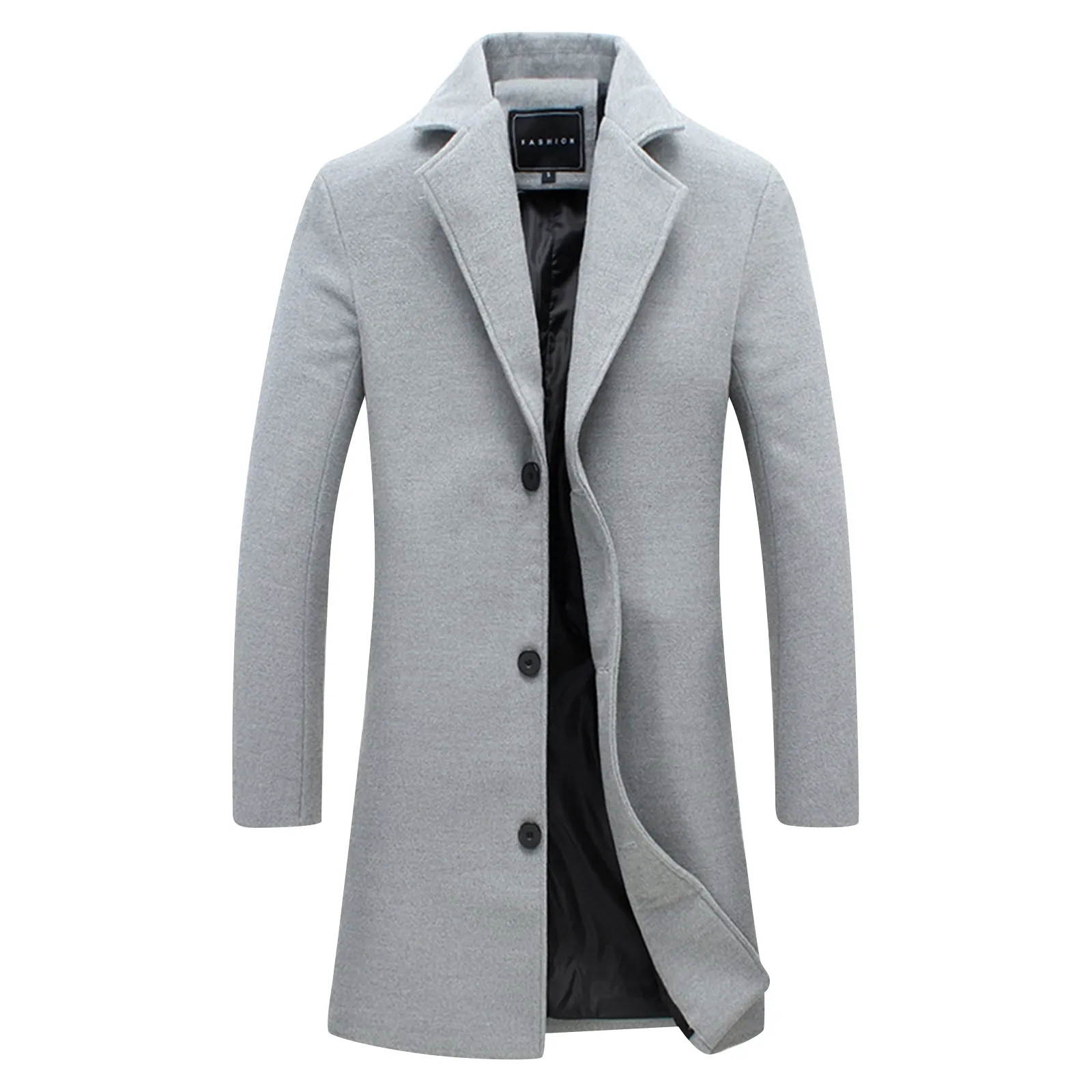
Browse our selection of durable wool coats to see these quality features in action.
Timeless Appeal: Design That Defies Trends
Unlike seasonal fashion items, the pea coat’s core design has remained remarkably consistent for over a century. This timelessness represents genuine value, as your investment won’t look outdated after a single season.
The Value of Style Longevity
The pea coat’s classic silhouette offers several practical advantages:
- Versatility Across Wardrobes: The pea coat complements both casual attire (jeans and boots) and formal wear (suits and dress shoes) equally well
- Trend Resistance: The fundamental design elements have remained essentially unchanged for decades, meaning today’s investment will still look appropriate years from now
- Seasonless Appeal: The clean lines and proportional design work across varied weather conditions when layered appropriately
Design Elements Worth Their Premium
Specific features contribute to the pea coat’s enduring appeal:
- The proportioned double-breasted front creates a flattering silhouette for most body types
- The convertible collar can be worn up for protection or down for a more polished look
- The slightly fitted waist creates a masculine shape without restricting movement
- The mid-thigh length offers practical coverage while maintaining versatility
These design elements have been refined over decades of real-world use, resulting in a garment that combines aesthetic appeal with genuine functionality—a combination that justifies premium pricing.
When comparing different classic coat styles, understanding the differences between a wool car coat vs. pea coat helps clarify the value proposition. For more styling options, our ultimate guide to pea coats in winter provides detailed information.
Brand Heritage and Reputation
Established brands with proven track records in outerwear production often command higher prices, and for good reason. This premium reflects both tangible and intangible value factors.
Quality Assurance Through Reputation
Renowned manufacturers stake their reputation on every garment they produce:
- Established brands typically have more rigorous quality control processes
- They maintain consistent standards across production runs
- Their experience allows them to source superior materials through long-standing relationships
- Their reputation provides an implicit guarantee of quality
Investment in Excellence
Premium brands invest substantially in elements that affect the final product:
- Research and development for improved materials and construction techniques
- Skilled pattern makers who refine fit and functionality
- Multiple inspection stages throughout production
- Customer feedback integration for continuous improvement
While brand prestige itself may account for some price premium, reputable manufacturers generally earn their higher pricing through genuine quality differences rather than marketing alone. The knowledge and expertise accumulated over years of specialization translate directly to superior garments.
For those interested in heritage design elements, our guide on what makes a coat vintage-inspired explains the historical details that quality manufacturers preserve.
Understanding Value Tiers: What You Get at Different Price Points
Not all pea coats are created equal, and understanding what you get at different price points helps make an informed purchase decision.
| Price Range | Typical Materials | Construction Quality | Expected Longevity | Common Features |
|---|---|---|---|---|
| Entry-level ($100-200) | Wool blends (20-60% wool), synthetic lining | Machine-constructed with basic stitching | 1-3 seasons | Basic design, limited insulation, plastic buttons |
| Mid-range ($200-400) | Higher wool content (60-90%), better lining | Improved stitching, some reinforcement | 3-6 seasons | Better insulation, some traditional features, mixed-quality hardware |
| Premium ($400-700) | 90-100% wool (24-32oz), quality lining | Reinforced construction, attention to details | 8-15+ years | Excellent insulation, traditional design elements, quality hardware |
| Luxury ($700+) | 100% premium wool, luxury linings (e.g., satin) | Hand-finished elements, meticulous detail | 15-30+ years | Superior insulation, refined finish, premium hardware, perfect fit |
At lower price points, compromises typically affect durability and performance more than immediate appearance. A $150 coat might look similar to a $500 coat on the rack but will reveal its limitations through wear, weather exposure, and time.
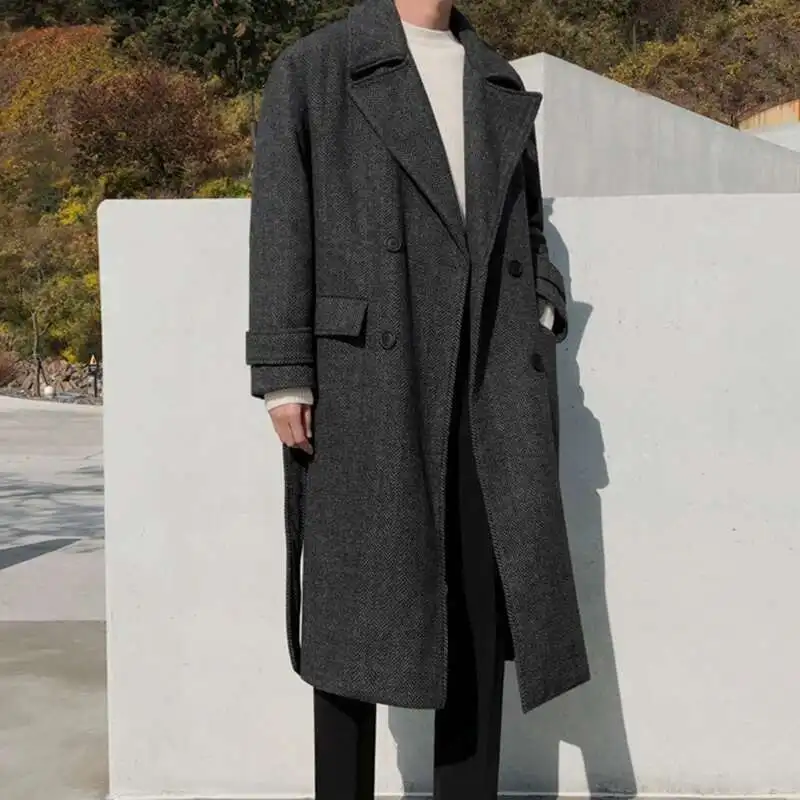
When evaluating different price tiers, understanding guidance on choosing the right coat proportions helps ensure value at any budget.
How to Assess Quality: What Justifies the Price
When shopping for a pea coat, knowing how to evaluate quality helps ensure you’re paying for genuine value rather than marketing hype.
Material Assessment
- Fabric Test: Quality wool feels substantial and slightly rough, not slick or thin
- Weight Check: Premium coats have a noticeable heft when lifted
- Composition Check: Look for high wool percentages (ideally 80-100%)
- Lining Inspection: Quality linings lie flat, show careful stitching, and feel substantial
Construction Evaluation
- Seam Examination: Look for tight, even stitching with no loose threads
- Button Attachment: Quality buttons are securely fastened with reinforcement
- Pattern Alignment: Check that patterns match at seams and pockets
- Inside Finishing: Quality coats look nearly as good turned inside out as they do right-side out
Fit Indicators
- Shoulder Placement: The shoulder seam should align with your natural shoulder edge
- Collar Stand: The collar should lie flat when down and stand properly when raised
- Movement Ease: You should be able to cross your arms comfortably while buttoned
- Length Appropriateness: The hem should hit mid-thigh for proper proportion
Understanding proper information on proper fit assessment helps ensure you’re getting value for your investment.
Mens Double Breasted Pea Coat, Mens Wool Blend Coat, Mens Wool Pea Coat
Price range: $136.84 through $157.36 Select options This product has multiple variants. The options may be chosen on the product pageMens Cashmere Overcoat, Mens Hooded Winter Coat, Mens Wool Blend Coat
Price range: $128.72 through $139.68 Select options This product has multiple variants. The options may be chosen on the product pageMens Black Overcoat, Mens Black Wool Coat, Mens Wool Overcoat
$339.18 Select options This product has multiple variants. The options may be chosen on the product pageMens Double Breasted Pea Coat, Mens Hooded Winter Coat, Mens Quilted Coat
Price range: $81.00 through $108.48 Select options This product has multiple variants. The options may be chosen on the product pageMens Grey Overcoat, Mens Wool Blend Coat, Mens Wool Overcoat
$201.28 Select options This product has multiple variants. The options may be chosen on the product pageMens Long Wool Coat, Mens Wool Blend Coat
Price range: $97.40 through $128.36 Select options This product has multiple variants. The options may be chosen on the product page
Finding Value: Smart Shopping Strategies
Getting the best value for your investment doesn’t necessarily mean spending the absolute minimum—it means maximizing the quality-to-price ratio.
Shop Off-Season: Purchase pea coats in late winter or early spring when retailers discount winter merchandise (potential savings: 30-50%)
Consider Vintage Options: Well-maintained vintage pea coats often offer exceptional quality at lower prices, though sizing may be more challenging
Prioritize Key Features: If budget-constrained, focus on wool content and construction quality over brand name or minor details
Watch for Sales at Quality Retailers: Premium stores often discount quality merchandise seasonally rather than stocking lower-quality alternatives
Care for Your Investment: Proper maintenance extends coat life substantially:
– Store on proper hangers to maintain shape
– Clean according to manufacturer instructions
– Address minor damage promptly
– Weatherproof appropriately
By approaching your purchase strategically and maintaining your investment properly, you can maximize value regardless of your budget.
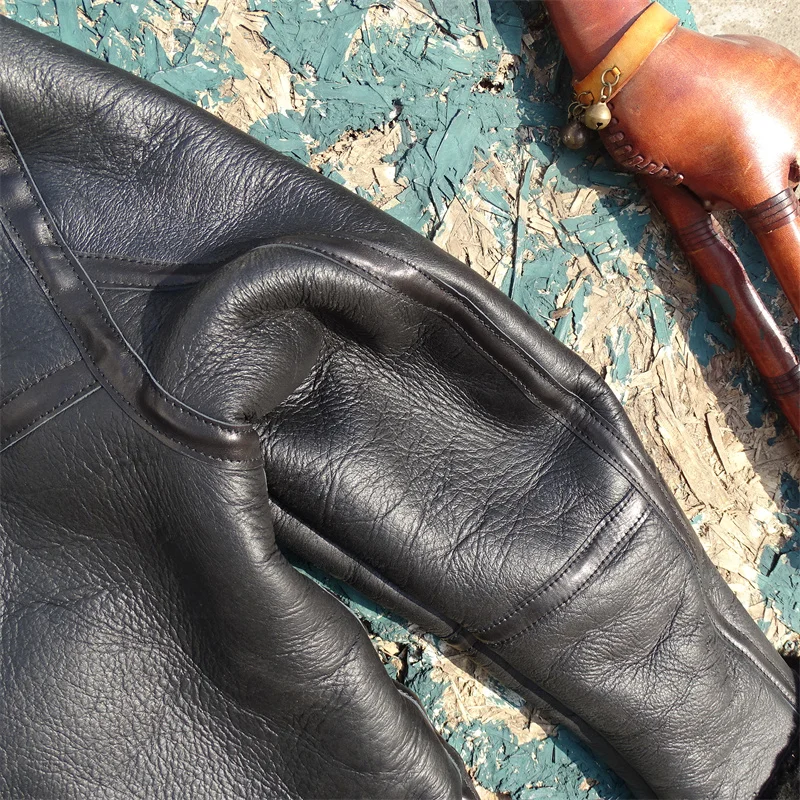
Are Expensive Pea Coats Worth It? Making Your Decision
After examining the factors that contribute to pea coat pricing, the question remains: is the investment justified for you personally?
The value proposition of a premium pea coat makes most sense when:
- You live in a climate with distinct cold seasons where the coat will see regular use
- You appreciate quality craftsmanship and materials that improve with age
- Your personal style favors classic, timeless pieces over seasonal trends
- You take a long-term view of wardrobe building rather than following fast fashion
Conversely, a high-end pea coat might be less justified if:
– Your climate offers limited opportunities to wear heavy outerwear
– Your style changes frequently with trends
– You prefer variety over quality in your wardrobe
Remember that “expensive” is always relative to value received. A $500 coat worn and enjoyed for a decade provides better value than a $200 coat discarded after two seasons. At Metro Cloak, we believe in creating outerwear that stands the test of time—both in style and durability.
For those considering other premium outerwear investments, our guide on whether a cashmere overcoat is worth the investment offers comparable considerations.
The true value of a quality pea coat extends beyond its price tag—it’s measured in years of service, protection from the elements, and the confidence that comes from wearing a garment crafted with care and expertise.


